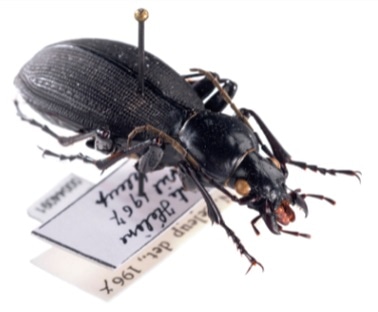Natural history collections across the globe exhibit museum specimens that hold a wealth of underused genetic information because their DNA is poorly preserved. This makes it hard to sequence the DNA.

Aplothorax burchelli, the giant carabid of St-Helena, now extinct and of which three specimens are kept in the Museum of Geneva. Image Credit: © Philippe Wagneur / Muséum Genève.
Headed by scientists from the University of Geneva (UNIGE) and the Museum of Natural History of the City of Geneva (MHN), an international team has improved a technique devised for investigating ancient DNA to determine the link between species on a deep evolutionary scale. The study has been published in the Genome Biology and Evolution journal.
The links relationships between different species can be established and the key steps in the evolution of organisms from a common ancestor can be traced by combining and comparing the sequences of a huge number of genes or complete genomes.
Such phylogenomic studies rely on the amplification and sequencing of DNA fragments, which are followed by bioinformatics analyses for comparing the sequences. Thus, they often necessitate well-preserved, carefully sampled DNA.
Deciphering degraded DNA
Therefore, the secrets behind a majority of the specimens preserved in natural history museums have not yet been unraveled. This is because in most cases, the DNA is usually highly degraded and challenging to sequence.
Guided by Emmanuel Toussaint, a researcher at the MHN, and Nadir Alvarez, a researcher at the Department of Genetics and Evolution of the Faculty of Science of the UNIGE and chief curator at the MHN, an international team of researchers has optimized a technique that is already in use for well-preserved samples, to use it on DNA highly fragmented because of partial degradation.
The HyRAD-X technique involves fishing out fragments of the genome to be examined with DNA probes from closely linked species. Then, the fragments are sequenced to find the differences between the genomes. But these DNA probes prove effective only for closely linked genomes, and to date, this technique had only enabled researchers to follow the evolution of a single species over time.
As part of this study, the researchers employed HyRAD-X RNA probes rather than DNA probes to identify fragments of interest in the genome. RNAs—copies of DNA molecules that transfer the information the genome encodes—exhibit a very strong affinity for DNA, and RNA-DNA pairings happen more readily compared to DNA-DNA pairings.
Thus, RNA probes are more efficient hooks, specifically when the to-be-analyzed genomes show huge levels of divergence.
Thanks to this new method, we were able to trace the evolutionary history, not within a single species over a million years, but within several species and over tens of millions of years!”
Emmanuel Toussaint, Study First Author, Natural History Museum of Geneva
The genealogy of the carabid beetle better known
The team was specifically interested in the specimens of an emblematic carabid obtained from the island of Saint Helena in the middle of the Atlantic Ocean, gathered in the 1960s and preserved at the MHN in Geneva.
The investigation of the DNA of these beetles showed that this species, which is now extinct and so far classified in the genus Aplothorax, originally falls into the genus Calosoma. Also, it enabled locating its biogeographic origin possibly in Africa, and to produce the chronology of the evolution of the subfamily Carabinae, the origin of which is dated back to the Lower Cretaceous.
Our study opens many perspectives to establish the evolutionary history of millions of specimens in museum collections around the world.”
Nadir Alvarez, Natural History Museum of Geneva and University of Geneva
Source:
Journal reference:
Toussaint, E. F. A., et al. (2021) HyRAD-X exome capture museomics unravels giant ground beetle evolution. Genome Biology and Evolution. doi.org/10.1093/gbe/evab112.